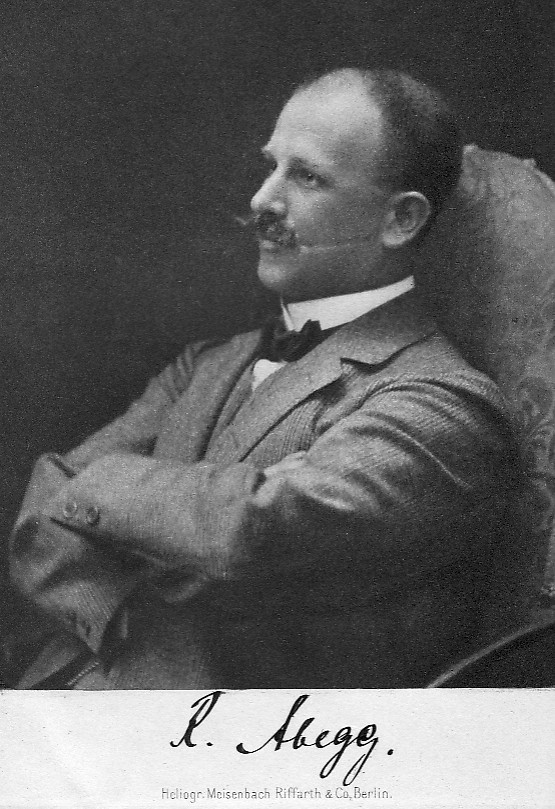- Richard Abegg
Infobox_Scientist
name = Richard Abegg
caption = Richard Wilhelm Heinrich Abegg (1869-1910)
birth_date = birth date|1869|1|9|mf=y
birth_place =Danzig ,Germany
residence =Germany
nationality = German
death_date = death date and age|1910|4|3|1869|1|9|mf=y
death_place = Tessin,Germany
field =Chemist
work_institution =University of Göttingen University of Stockholm TH Breslau
alma_mater =University of Kiel University of Tübingen University of Berlin
doctoral_advisor =August Wilhelm von Hofmann
doctoral_students =Clara Immerwahr
known_for =Abegg's rule
prizes =
religion =
footnotes =Richard Wilhelm Heinrich Abegg (1869 – 1910) was a German
chemist and pioneer of valence theory. Because of his research he proposed that the difference of the maximum positive and negative valence of an element tends to be eight. This has become to be calledAbegg's rule . He was a gas balloon enthusiast, which caused his death at the age of 41 when he crashed in his balloon "Schlesien".Abegg received his PhD in
19 July 1891 under Hofmann at theUniversity of Berlin . Abegg learned organic chemistry from Hofmann, but one year after finishing his PhD degree turned to physical chemistry while studying with Ostwald (Leipzig). Abegg later served as Nernst's (Göttingen) and Arrhenius' (Stockholm) private assistant.He discovered the theory of freezing point depression and anticipated Lewis' octet rule by pointing out that the lowest and highest oxidation states of elements often differ by eight. He studied alkali metal polyiodides, electrochemical potentials in non-aqueous solutions, and the dielectric constant of ice.
Richard Abegg was the son of Wilhelm Abegg and Margarete Friedenthal. After attending Wilhelm high school in Berlin, Abegg matriculated in physical chemistry at the
University of Kiel . Later, he shifted to Tübingen and Berlin. In 1899, Abegg becamePrivatdozent and one of the leaders of the chemical institute inBreslau . One year later he became a professor at the university.Clara Immerwahr (first wife ofFritz Haber ) studied and graduated under him. in 1909, he became full professor at the TH Breslau. Together with his colleagueGuido Bodländer , he published on electro-affinity, then a new principle in inorganic chemistry. Abegg occupied himself with photography and hot balloon trips. He was the founder and chairperson of the Silesian club for aeronautics inBreslau . Furthermore, he practiced an assessor's function in the presidency of the German air sailors' association. His wife Lina was also a ballooning enthusiast. From 1901, Abegg was active with an electrochemistry journal as editor. Abegg introduced the concept of the electro-affinity into chemistry and made the basis for the handbook of the inorganic chemistry (1905–1939). In 1904, Abegg formulated the valence rule, after which the highest positive and highest negative electro-valence of an element yields 8 altogether. This is calledAbegg's rule . The Prussian secretary of stateWilhelm Abegg was his brother.Books by Abegg
* "Über das Chrysen und seine Derivate." Schade, Berlin 1891
* "Anleitung zur Berechnung volumetrischer Analysen." Grass, Barth & Co, Breslau 1900
* "Die Theorie der elektrolytischen Dissociation." Enke, Stuttgart 1903References
* cite journal
author = Walter Hills
title = Obituary notices: Richard Abegg, 1869–1910; Michael Carteighe, 1841–1910; Oscar Guttmann, 1855–1910; Charles Hanson Greville
journal = J. Chem. Soc. Trans.
year = 1911
volume = 99
issue = 1
pages = 599–602
doi = 10.1039/CT9119900599
* "Am. Chem. J." 1910, 43, pp. 563-564.
*cite journal
author =Walther Nernst
title = Obituary Richard Abegg
journal =Berichte der deutschen chemischen Gesellschaft
year = 1913
volume = 46
issue = 1
pages = 619–628
doi = 10.1002/cber.19130460182
* J.R. Partington, "A History of Chemistry," Macmillan, 1964, vol. 4, p. 662.
* I. Asimov, "Asimov's Biographical Encyclopedia of Science and Technology" (2nd Ed.), Doubleday, 1982, p. 625.
* "A Biographical Dictionary of Scientists," Williams, T. I., Ed., Wiley, 1969, p. 1.
* "Z. Elektrochem," 1910, 16, pp. 554-557.
* "Neue Deutsche Biographie," Duncker & Humblot, 1953-1990, vol. 1, p. 7.External links
* [http://www.3rd1000.com/history/nuclear.htm Nuclear Atom] - contains and excerpt of Abegg's contributions.
* [http://www.nernst.de/abegg/abegg.htm Abegg biography]Persondata
NAME= Abegg, Richard
ALTERNATIVE NAMES=Abegg, Richard Wilhelm Heinrich
SHORT DESCRIPTION= Germanchemist
DATE OF BIRTH=January 9 ,1869
PLACE OF BIRTH=Danzig ,Germany
DATE OF DEATH=April 3 ,1910
PLACE OF DEATH=Tessin ,Germany
Wikimedia Foundation. 2010.
